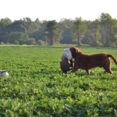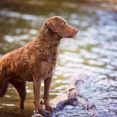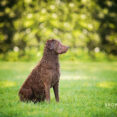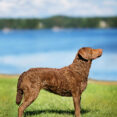This article is written by Nat Baxter, DVM. It is a good reminder on how to help avoid heat stroke in dogs, especially in these warm summer months.
The first thing that needs to be understood is that dogs and people are different enough that most of the info cannot cross lines. I do not profess to know what the appropriate procedures for people other than what I learned in first aid.
Dogs do not lose enough electrolytes thru exercise to make a difference, but if the dog gets truly into heat stroke the physiology changes will make them necessary. BUT oral replacement at that point is futile, they need intravenous fluids and electrolytes and lots of it.
Cooling: Evaporative cooling is the most efficient mean of cooling. However, in a muggy environment, the moisture will not evaporate so cooling does not happen well. I cool with the coldest water I can find and will use ice depending on the situation. The best way is to run water over the dog, so there is always fresh water in contact with the skin. When you immerse a dog in a tub, the water trapped in the hair coat will get warm next to the dog, and act as an insulator against the cool water and cooling stops. If you can run water over the dog and place it in front of a fan that is the best. Misting the dog with water will only help if you are in a dry environment or in front of a fan. Just getting the dog wet is not the point, you want the water to be cool itself, or to evaporate.
For MOST situations all you will need to do is get the dog in a cooler environment, ie shade, or in the cab of the truck with the air conditioning on (driving around so the truck does not overheat and the AC is more efficient). Up to a couple of years ago, I was very concerned about my dogs getting too hot in the back of my black pickup with a black cap. New white truck fixed a lot of that problem. When I had one dog I just pulled the wire crate out of the car and put it in some shade and hopefully a breeze. But having 2 dogs and running from one stake to another, that was not feasible. So I built a platform to put the wire crates on, this raises the dog up in the truck box where the air flow is better. Then I placed a 3 speed box fan in front blowing on the dogs with a foot of space to allow better airflow. I purchased a power inverter that connects to the battery and allows the 3 speed fan to run from the truck power. It has an automatic feature that prevents it from draining the battery. When I turned that fan on medium I would find that the dogs where asleep, breathing slowly and appeared very relaxed and comfortable in a matter of 20 minutes or less, even on very hot muggy days.
Alcohol: I do carry it for emergiencies. It is very effective at cooling due to the rapid evaporation. It should be used when other methods are not working. You should be on your way to the veterinarian before you get to this point. We recommend using rubbing alcohol, which is propylene alcohol, not ethyl, for those of you not aware. So do not try to drink it. Alcohol should be used on the pads and lower feet area where there is little more than skin and blood vessels over the bones. Use a little bit and let it evaporate, you can use too much as some is absorbed through the skin. There are concerns about toxicity, but you have to get the temperature down.
I purchased those cooling pads that you soak in cold water, but found that the dogs would not lay on them. I would hold them on the back of a dog that just worked to get a quick cool, but have not use them for years. I also bought a pair of battery operated fans but found them pretty useless. Spend your money on the power inverter and get a real fan.
Watching temperature: If you feel your dog is in danger of heat injury, check its temp and write it down. Keep checking the temp every 3 minutes. I recommend to get a “rectal glass thermometer. The digital ones for the drug store I have found to be very unreliable, Don’t forget to shake it down completely each time, sounds silly, but when are worried about your companion, things tend to get mixed up. This is VERY IMPORTANT**once the temp STARTS to drop, STOP ALL COOLING EFFORTS. The cooling process will continue even though you have stopped. If the temp starts at 106.5, and then next time it drops to 105.5, stop cooling the dog, dry it off, and continue monitoring. You will be amazed how it continues to go down. If you do not stop until the temp is 102, the temp will drop way too low. I cannot emphasis this point enough.
When the dog is so heated that it is panting severely, only let it have a few laps of water. Water in the stomach does not cool the dog, you just need to keep the mouth wet so the panting is more effective. Do not worry about hydration until the temp has started down. A dog panting heavily taking in large amounts of water is a risk of bloat. Due to the heavy panting they will swallow air, mixed with a large amount of water they can bloat. Once the temp is going down and panting has slowed to more normal panting then allow water. The dog will rehydrate it self after temp is normal. If the dog has a serious problem and even though you have gotten the temp normal, get the dog to a vet, as it can still need IV fluids and some medication. Also, a case of heat stroke can induce a case of hemorrhagic gastroenteritis (not parvo), with a ton of very bloody diarrhea and a lot of fluid and electrolyte loss. These cases need aggressive treatment. =
The best method of treatment is prevention. Learn to watch your dog, and see the changes in the size of the tongue, and how quickly it goes down. Learn your dogs response to the different environments, and be careful when you head south for an early season hunt test or trial. I have been to Nashville at the end of May, only 5 hours away, but the difference in temp and humidity did effect the dogs as they were used to more spring weather in Ohio. Try different things in training to help the dog cool and learn what works better. Another very important point=> Do not swim your hot dog to cool it then put in put in a box/tight crate. Remember, evaporation can not take place in a tight space, and the box will turn into a sauna and you will cook your dog. Carry a stake out chain, and let the dog cool and dry before putting it up. I demonstrated this lesson this spring with my 10 monthold pup. After doing a 15 minute session in yard drill on a warm 70+ degree day, she was panting pretty hard and was pretty hot. She was OK but it was time to stop. Just for the heck of it I took her temp. She was 103.6, above normal but too bad for a dog that had just finished working. In my back yard I have a 300 gallon Rubbermaid tub filled with water. I took her to it and she jumped in and out 3-4 times. She appeared totally improved, tongue was much smaller, and eyes brighter and her full spring was back into her step. So I re-took her temp and it was 104.2, so even though she looked better she was hotter. This is a perfect lesson to show not get a hot dog wet and then put them in a box. The water on her skin caused the blood vessels to constrict, decreasing blood flow to the skin. Therefore the hot blood was shunted back to the dog’s core and retianed the heat. You may have felt the same thing, after exercising but still being very warm, take a shower and get cooled off but as soon as you turn the shower off you start sweating again.
I know this is a bit long, but hopefully this is easy to understand and helps provide some useful information.Remember: Prevention, learn your dog. It is worth the time and effort.






















